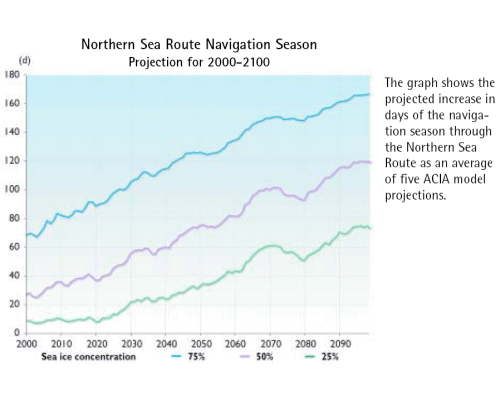 The possibility of a trans-arctic shipping route has intrigued seafarers since the days of the first Arctic explorers, as it would shorten the distance between the Pacific Ocean and the Atlantic Ocean significantly. Challenging weather conditions and the lack of adequate shipping technology trans arctic shipping has not become a viable possibility as of yet. Shipping in the Arctic is on the rise and it is estimated that approximately 6000 vessels are operating annually in the Arctic region, many of them making multiple voyages. Off these 6000 ships operating in the Arctic almost all of them are declinational, conducted for community re-supply, moving natural resources out of the Arctic or marine tourism.
The possibility of a trans-arctic shipping route has intrigued seafarers since the days of the first Arctic explorers, as it would shorten the distance between the Pacific Ocean and the Atlantic Ocean significantly. Challenging weather conditions and the lack of adequate shipping technology trans arctic shipping has not become a viable possibility as of yet. Shipping in the Arctic is on the rise and it is estimated that approximately 6000 vessels are operating annually in the Arctic region, many of them making multiple voyages. Off these 6000 ships operating in the Arctic almost all of them are declinational, conducted for community re-supply, moving natural resources out of the Arctic or marine tourism.
The fact that the Arctic ice cap has been receding at an unprecedented rate, recent advancements in shipping technologies and an increasing interest in the Arctic’s resources have made the matter one of the most prominent issues in the northern hemisphere. Existing shipping lanes barely manage the current traffic as the Suez and Panama canal’s serve as bottlenecks and are not capable of servicing the largest container vessels of today. It is to be expected that shipment through the Arctic will become a viable option in the future. With growing technology and a receding ice cap the quest for resources companies are reaching further into the arctic region for resources and tourism activities by cruise liners is on the rise.
 Currently there seems to be a consensus that all of these activities will increase further and that trans arctic shipping will become a reality, that it is just a matter of time. There are nonetheless significant challenges, and issues that need to be analyzed and dealt with to prevent environmental disasters and ensure the safety of seafarers. It is clear that the benefits of these activities can be significant, but the environmental hazards are numerous as well. Infrastructure and safety measures are lacking and need to be addressed. There is an ongoing debate if there is a need for mandatory regulations by the IMO. The jurisdiction over the waterway is also disputed most prominently between the U.S and Canada.
Currently there seems to be a consensus that all of these activities will increase further and that trans arctic shipping will become a reality, that it is just a matter of time. There are nonetheless significant challenges, and issues that need to be analyzed and dealt with to prevent environmental disasters and ensure the safety of seafarers. It is clear that the benefits of these activities can be significant, but the environmental hazards are numerous as well. Infrastructure and safety measures are lacking and need to be addressed. There is an ongoing debate if there is a need for mandatory regulations by the IMO. The jurisdiction over the waterway is also disputed most prominently between the U.S and Canada.
The matter has received substantial attention from researchers and organizations, some of these works can be found in the links bellow.
Links
Arctic Marine Shipping Assessment (AMAP) 2009 Report
Recently published report, which is very detailed and covers most of the outstanding issues, possibilities and challenges connected to shipping activities in the Arctic
North meets North, navigation and the future of the Arctic Report of a working group of the Ministry for Foreign Affairs Iceland 2006.
Gives a substantial overview of shipping in the Arctic and what it’s future might hold. It also examines the possibilities of a transshipment port in Iceland.
Arctic Shipping Activities into the next Decade1
By: Norwegian Maritime Directorate
Gives a brief overview over developments in shipping in different parts of Arctic Waters by type and estimates for future development in Arctic shipping.
Developments in Arctic Shipping
Produced by the research company Ocean Futures, Oslo for the Norwegian Atlantic Committee
Guidelines for Ships Operating in Arctic Ice-Covered Waters
Guidelines developed in 2002 by the International Maritime Organization for operating in Arctic Ice-Covered Waters
By: Øystein Jensen
Interesting report, which discusses if there is a need for mandatory guidelines for ships operating in Arctic Ice-covered waters.
United Nations Law of the Sea (UNCLOS) /Direct link to the UNCLOS agreement
International shipping is largely regulated by the UNCLOS agreement. All of the countries of the Arctic besides the U.S have ratified the agreement. They are non-the less to a great extent bound to it as customary international law.
Maps
Arctic sea routes
By UNEP
Ice Strengthened vessels and icebreakers
Finnish company dedicated to building icebreakers and ice strengthened cargo vessels.
The Yamal, a nuclear powered Icebreaker: Interesting information about the Russian icebreaker Yamal.
Conferences and symposiums related to Arctic shipping
International Symposium on Sea Ice in the Physical and Biogeochemical System
International Glaciological Society 31 May - 4 June 2010
